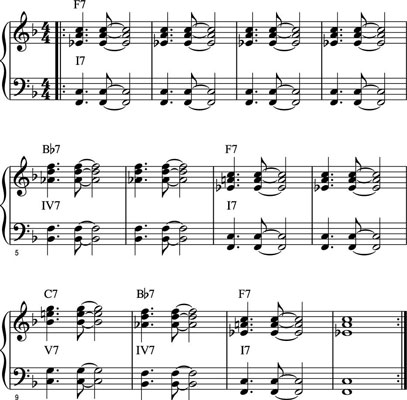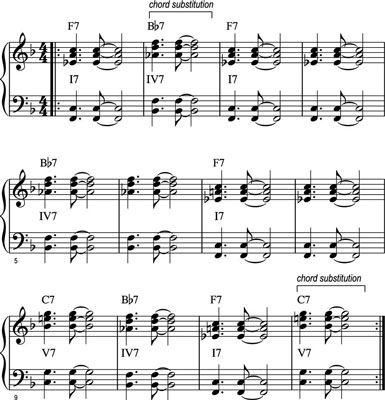The blues has its own scale. How do you apply the blues to the piano or keyboard? Its time to create your own blues from scratch. That’s right: You get to be a composer.
You can play fast blues, slow blues, happy blues, and sad blues. Whether your dog left you or your woman (or man) has done you wrong, playing the blues is as easy as counting to 12.
Two important elements in blues music are form and rhythm. When you have these down, add a few more essential musicalities, like grace notes or tremolos. Then you can make any of your songs sing the blues.
To play the blues, you use the following elements:
12-bar form (there are others, as mentioned earlier)
Swing or shuffle rhythm
Seventh chords
Tremolos
Sad story to tell (everybody’s got one)
12-bar ditties
Most blues music utilizes a widely recognized form called 12-bar form, aptly named because each musical phrase of the song is 12 bars (measures) long. The 12-bar blues has a chord sequence that repeats over and over, usually with different lyrics and perhaps some melodic variation, until you genuinely feel sorry for the storyteller.
Melody notes, rhythms, and lyrics may differ from one 12-bar phrase to the next, but the chords usually stay the same. The chords most often used in the 12-bar form are all seventh chords; they are as follows:
The I7 chord: Chord with the first scale note as its root note
The IV7 chord: Chord with the fourth scale note as its root note
The V7 chord: Chord with the fifth scale note as its root note
These three chords appear in the same order and for the same number of measures every time the 12-bar phrase is repeated.
To play your own 12-bar blues, just follow these easy instructions, playing with either hand or both hands. When you have the chord progression memorized, try playing the chords with the left hand while your right hand plays a simple melody, riff, or blues scale.
Play an I7 chord for four measures.
Play an IV7 chord for two measures.
Play an I7 chord for two measures.
Play a V7 chord for one measure.
Play an IV7 chord for one measure.
Play an I7 chord for two measures.
Repeat Steps 1 through 6 until you have your audience singing with you.
This is an example of 12-bar blues that uses chords only. They may be just chords, but you should still play them with conviction. Listen to this 12-bar blues progression in Book IV, Chapter 2, Audio Track 92.

Changing it up
All blues players realize that the same chords over and over can become repetitive (to both audience and musician), so they substitute other chords within the 12-bar form. For example, try a IV chord in measure 2 and play a V7 chord in measure 12 as a turnaround.


